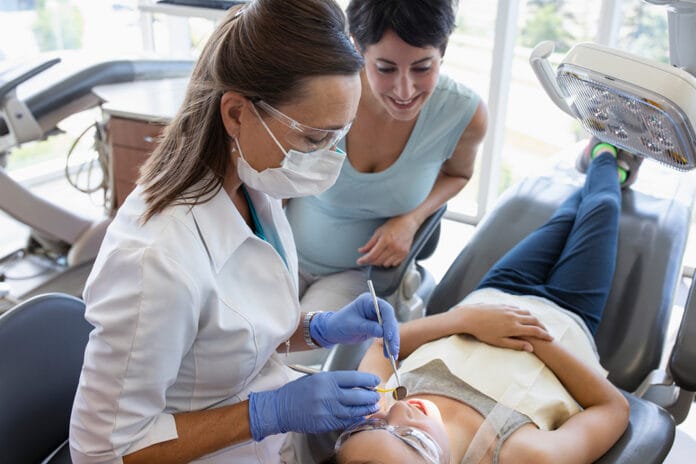In order to become a licensed dental hygienist in the United States, individuals must meet three basic requirements: an educational requirement, a written examination requirement, and a clinical examination requirement.1 Once a student graduates from an accredited dental hygiene program, they must take the National Board Dental Hygiene Exam (NBDHE) offered by the Joint Commission on National Dental Examinations (JCNDE) to practice in the United States.1
Clinical examinations for dental hygiene are not currently offered at the national level. Instead, there are four clinical testing agencies: Council of Interstate Testing Agencies (CITA), Central Regional Dental Testing Service (CRDTS), Southern Regional Testing Agency (SRTA), Commission on Dental Competency Assessments (CDCA), and Western Regional Examining Board (WREB), which merged into the CDCA-WREB as of August 4, 2021.1
Each testing agency covers a region of the United States, with each state accepting specific clinical exams for licensure.2 All testing agencies offer different clinical examinations apart from the CDCA-WREB (which will provide the WREB exam until the end of 2022) and CITA, which offers the ADEX dental hygiene clinical licensure examination.1
This article will discuss the benefits of having a national clinical dental hygiene exam as opposed to the system currently in place and why a change is needed.
Freedom of Movement
The clinical licensing examination has come a long way since 1928.3 According to the Commission on Dental Competency Assessments (CDCA), there used to be 53 different licensure exams in the United States, with each state responsible for its respective exam.2,3 In 1969, the North East Regional Board of Dental Examiners (NERB, now the CDCA) was created with the goal of eliminating unnecessary repetition of clinical exams if a practitioner were to move and practice in another state.2
Soon, states/jurisdictions joined together to form the different regional exams we have today.2 Although four regional exams are much better than 53, the ultimate goal is to have one national clinical exam to further improve the transferability of clinical exams between states. One national exam will allow dental hygienists to have more freedom to move across states and provide dental care in more remote areas that need attention.
Patients Used for Exams
Another issue with clinical examinations is the use of human test subjects.3 According to the American Student Dental Association (ASDA) white paper (2016), dentistry is the only profession in the U.S. requiring clinical licensing examinations to be performed on human subjects to obtain licensure.3 This practice began in the 1900s and is still practiced today despite many claims of reliability, validity, and ethical issues with the use of human test subjects.3,4
Students are faced with the difficult and time-consuming process of finding a patient who meets exam requirements and will show up on exam day.4 Some took this opportunity to create a business that provides exam patients for a premium, treating patients more like a “commodity” than a “complex person with comprehensive care needs.”3 ASDA argues that this “inhumane treatment” is unacceptable and a direct consequence of using human test subjects for clinical exams.3
Moreover, assuming the patient shows up and is approved for the clinical exam process, only a limited range of procedures are tested, making the exam an unreliable system for determining the competence of a dental practitioner.3,4 Patients’ mouths are also not created equally, resulting in unfair exam conditions among students and making it impossible to standardize the exam.3,4
Furthermore, many patients are shared between dental practitioners to complete specific procedures, and treatment is often withheld until examination day.3,4 In this instance, the patient’s immediate needs are neglected.3,4
Examination failure often results from malpractice or substandard treatment which, according to Laskey et al. (2003), there is no protocol to remedy or retreat these failed procedures on clinical licensing exam patients.4 Patients also don’t receive complete treatment or a clinical follow-up on treatment afterward.4
Proposed Solution
Two potential solutions have developed from dental professionals lobbying for a change to clinical licensure examinations. The American Dental Association (ADA) Board of Trustees voted in February 2017 to create a national clinical dental licensure exam modeled after the Objective Structured Clinical Examination (OSCE).5 The OSCE was first designed in 1975 by Harden for the medical profession to “improve the validity and reliability of assessment of performance” in students.6,7
An OSCE involves a series of stations with different examiners to assess the student’s clinical knowledge and critical thinking skills in simulated environments.6,7 The ADA believed that implementing an OSCE-modeled exam would create fairness among students and avoid examiner bias.5
This new exam was implemented in 2020 and is called the Dental Licensure Objective Structured Clinical Examination (DLOSCE).5 The Coalition of Dental Licensure Reforms’ goal is to replace the clinical live-patient exam (LPE) with the DLOSCE.8 The Dental Hygiene Licensure Objective Structured Clinical Examination (DHLOSCE) is expected to launch in 2024 also with the intent to eliminate the LPE.1 According to a survey of dental hygiene program directors, the majority were in favor of eliminating LPE and agreed that an OSCE-modeled exam would create more valid and reliable assessments by removing the variability of live patients and introducing a more comprehensive examination.8
Although the OSCE-model exams would eliminate much of the reliability, validity, and ethical issues with LPEs, some argue that an OSCE is not a good replacement for the LPE as it doesn’t involve any hands-on skills.5 The use of manikins instead of human subjects was recently implemented in regional clinical exams due to COVID-19 restrictions and safety issues for both students and patients. This alternative regional licensure exam is not currently accepted nationwide, with many states only temporarily allowing it.2 Both alternative exams ‒ the OSCE and manikin exam ‒ help eliminate the ethical issues involved by using live patients for clinical licensure examinations and are expected to stay.2
A national clinical licensure examination in dental hygiene would greatly benefit the profession. It would create more transferability between states and foster greater access to care as dental hygienists are permitted greater freedom to move to more remote areas. Eliminating the live patient-based clinical exam for a more modernized manikin and/or OSCE-modeled exam would create more reliability and validity and eliminate the ethical issues associated with using human test subjects. The development of the DLOSCE and the future development of the DHLOSCE seem to be progressive steps toward realizing these goals of fairness and equality for the rising generation of dental professionals.
Before you leave, check out the Today’s RDH self-study CE courses. All courses are peer-reviewed and non-sponsored to focus solely on high-quality education. Click here now.
Listen to the Today’s RDH Dental Hygiene Podcast Below:
References
- National Board Dental Examinations. (n.d.). American Dental Association Joint Commission on National Dental Examinations. https://jcnde.ada.org/en/examinations
- About the CDCA. (n.d.). The Commission on Dental Competency Assessments. https://www.cdcaexams.org/about-the-cdca/
- Use of Human Subjects in Clinical Licensure Examinations. (2016, October 31). American Student Dental Association. https://www.asdanet.org/docs/advocate/issues/asda_white-paper_licensure_web_final.pdf?sfvrsn=a0a868dd_18
- Laskey, R.E., Shub, J.L. Dental Licensure Reaches a Crossroads: The Rationale and Method for Reform. Journal of Dental Education. 2003; 67(3): 295-300.
- Solana, K. (2017). ADA Board of Trustees Votes to Create National Dental Licensure Exam. American Dental Association. https://editions.mydigitalpublication.com/publication/?i=393013&article_id=2737948&view=articleBrowser&ver=html5
- Khan, K., Ramachandran, S., Gaunt, K., Pushkar, P. The Objective Structured Clinical Examination (OSCE): AMEE Guide No. 81. Part I: An Historical and Theoretical Perspective. Medical Teacher. 2013; 35(9): e1437-e1446.
- Khan, K., Gaunt, K., Ramachandran, S., Pushkar, P. The Objective Structured Clinical Examination (OSCE): AMEE Guide No. 81. Part II: Organization & Administration. Medical Teacher. 2013; 35(9): e1447-e1463.
- Nieto, V.K., Eagle, I., Mishler, S., Rulli, D. Utilization of Objective Structured Clinical Examinations (OSCE) as an Assessment for Clinical Competency and Licensure: A survey of dental hygiene director’s knowledge and attitudes. Journal of Dental Hygiene. 2020; 94(6): 65-71.










